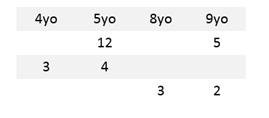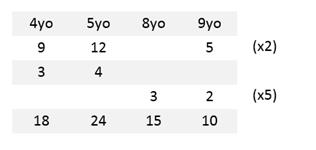Explanation
Since we have more than two parts in the overall ratio
here, a table is useful:

The various two-part relationships are written on
different rows because they have not yet been related to each other. We can
relate them through multiples. For example, by tripling the 4 in the second row
and comparing with the first row, we can see that the top-left-most entry
should be 9.
To combine the first row and the third row, we need to
relate them based on the last column, which we can do by converting both into
the common multiple of 10. We can write the multiple of the first row as a new
row and fill in the missing multiple from the third row:

Therefore, the ratio of four-year-old's to
eight-year-old's is 18 to 15, or![]() to
to ![]() .
.
The correct answer is (D).
If you believe you have found an error in this question or explanation, please contact us and include the question title or URL in your message.